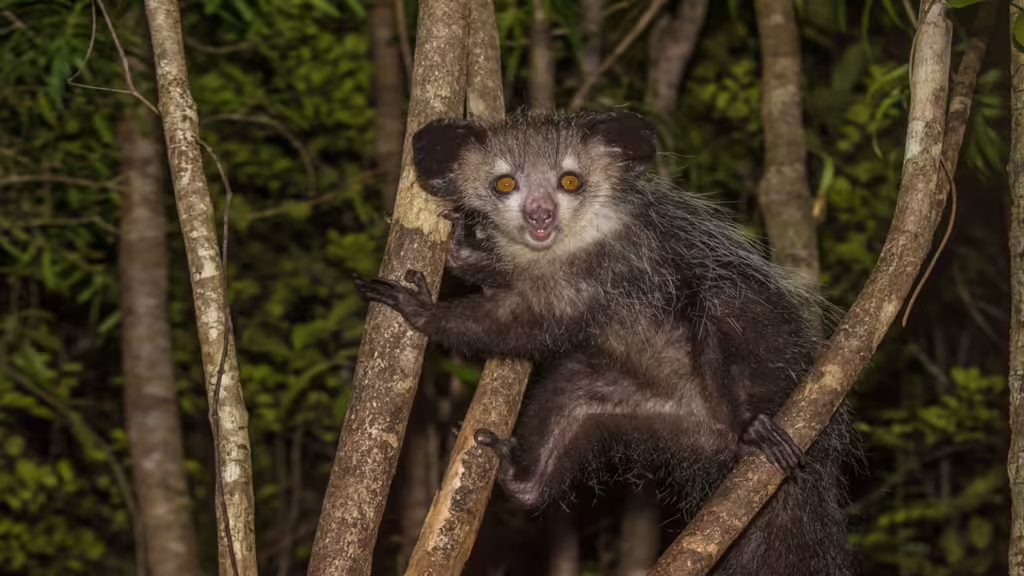The Aye-Aye (Daubentonia madagascariensis) is a fascinating and unique primate endemic to Madagascar. Known for its peculiar appearance and nocturnal habits, the Aye-Aye has intrigued scientists and animal lovers alike. This blog post delves into the various aspects of the Aye-Aye’s life, from its habitat and behavior to its diet and conservation status.
Natural Habitat
Aye-Ayes are primarily found in the dense tropical rainforests and deciduous forests along the eastern coast of Madagascar. They are arboreal creatures, spending most of their time in the treetops, where they build circular nests out of leaves, vines, and branches. These nests provide protection from predators and the elements.
Physical Characteristics
Aye-Ayes are medium-sized lemurs, characterized by their shaggy black fur, large eyes, prominent ears, and an elongated, bony middle finger. This unique finger is used for foraging, a method known as percussive foraging, where the Aye-Aye taps on trees to locate insect larvae. Their appearance, particularly the large eyes and long fingers, contributes to their somewhat eerie and intriguing look.
Behavior and Lifestyle
Aye-Ayes are nocturnal and solitary animals, spending their nights foraging for food and their days sleeping in nests. Despite being solitary, their home ranges often overlap, especially those of the opposite sex. They communicate through a variety of vocalizations and physical gestures, including a high-pitched “creak-creak” sound.
Feeding Habits
Aye-Ayes are omnivorous, with a diet consisting of insect larvae, fruits, nectar, seeds, and fungi. They use their elongated middle finger to tap on tree trunks, listening for the echoes that indicate hollow areas containing grubs. Once they locate their prey, they gnaw holes in the wood with their sharp incisors and extract the insects using their specialized finger.

Human Interaction and Handling
Due to their endangered status and specialized care needs, Aye-Ayes are rarely kept as pets. In their native habitat, they face threats from habitat destruction and local superstitions that associate them with bad luck, leading to their being killed on sight. Conservation efforts focus on habitat preservation and education to mitigate these threats.
Conditions for Keeping Aye-Ayes in Captivity
Captive Aye-Ayes require environments that closely mimic their natural habitat, including ample climbing structures and hiding places. Their diet in captivity includes a variety of fruits, insects, and specially formulated primate foods to ensure they receive proper nutrition.
Tank Setup
For those few kept in zoos, enclosures need to be large and enriched with natural vegetation and structures to allow for natural behaviors like foraging and nest building. The environment should maintain high humidity and appropriate temperatures to reflect the Aye-Aye’s native Madagascar habitat.
Reproduction and Life Cycle
Aye-Ayes do not have a specific breeding season and can reproduce throughout the year. Females give birth to a single offspring after a gestation period of approximately 170 days. The young are dependent on their mother for up to two years. Aye-Ayes reach sexual maturity around 2.5 to 3 years of age, and they can live over 20 years in the wild.
Conservation Status and Efforts
The Aye-Aye is listed as Endangered on the IUCN Red List, primarily due to habitat destruction, hunting, and superstitions. Conservation efforts include habitat protection, legal protection, and captive breeding programs to bolster wild populations. Education and community involvement are also critical in reducing superstitions and promoting conservation.
Fun Facts
- Percussive Foraging: Aye-Ayes use their elongated middle finger to tap on trees and locate insect larvae, similar to how woodpeckers forage.
- Unique Nests: They build intricate nests in trees, which they rarely reuse, often constructing multiple nests within their territory.
- Endemic to Madagascar: Aye-Ayes are found only in Madagascar, highlighting the island’s unique biodiversity.
Conclusion
The Aye-Aye is a remarkable and unique primate that plays a crucial role in Madagascar’s ecosystem. Understanding and protecting this species is essential for preserving the island’s rich biodiversity. By supporting conservation efforts and educating others about the importance of the Aye-Aye, we can help ensure the survival of this fascinating creature.
Dive Into the Fascinating World of Axolotls
Curious about axolotl care, behavior, and intriguing facts? Read our comprehensive article The Ultimate Guide to Axolotls: Care, Behavior, and Fun Facts to learn how to best care for these unique aquatic creatures and uncover their mysteries.




